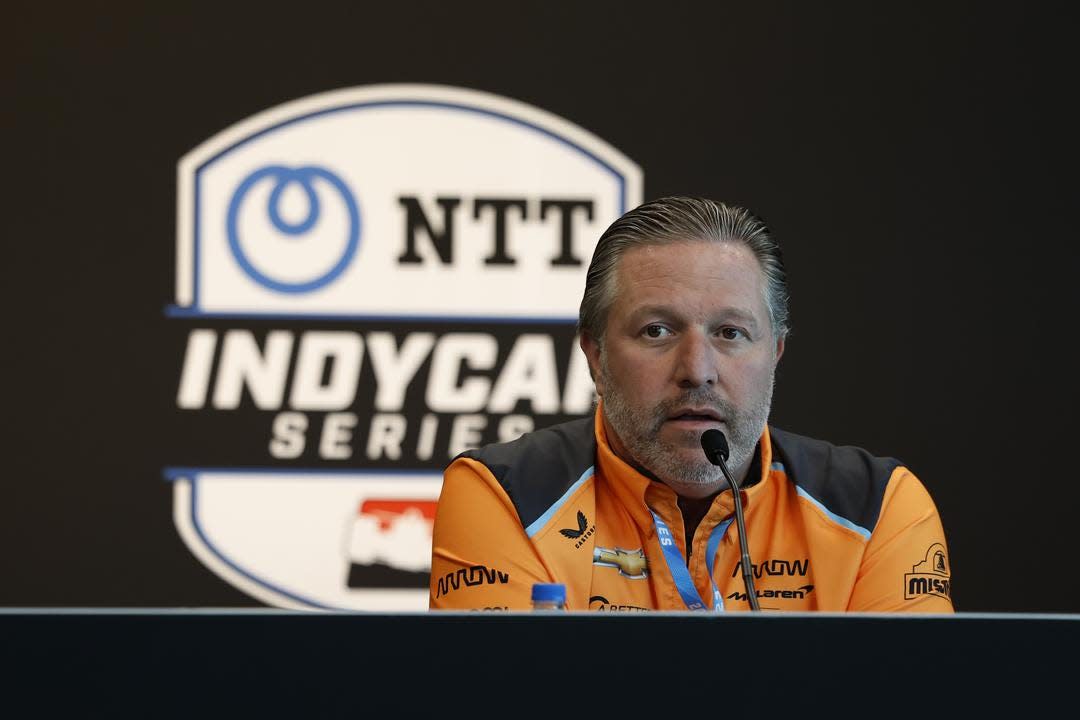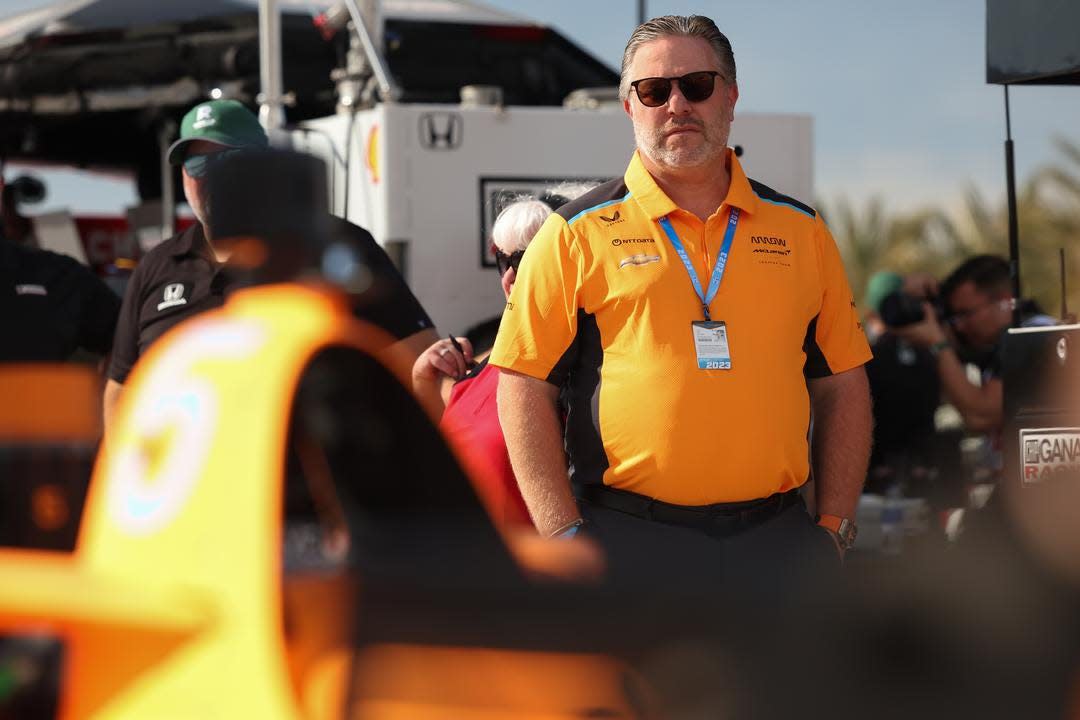'We need to make some moves': Zak Brown details ideas for IndyCar growth
LONG BEACH, Calif. – As Penske Entertainment officials mull a charter program, McLaren Racing CEO Zak Brown things IndyCar should take a page out of Formula 1’s book.
A full-time grid that for two years has existed at 27 cars and is set to reach 29 in 2025 – unless Penske Entertainment instills a cap – is several cars too big, Brown told a small group of assembled media Saturday afternoon at the Grand Prix of Long Beach. In Brown’s eyes, the cars regularly at the back of the field too often cause unnecessary yellow and red flags that have led to what he called “amateur driving” after last fall’s season-finale at Laguna Seca, and he questions how much value they add.

“I think we need to be very focused on quality over quantity on what we do,” Brown said. “I don’t think the fan pays a whole lot of attention after 20 cars, so what are those other six, seven, eight or nine bringing to the table, other than a lot of times creating red flags?
“I think the NASCAR show is no worse off by having a smaller car count than when you had to have 43 cars. We have 20 in Formula 1, and 27-29 (in IndyCar) creates a lot of reds in Nashville and a lot of yellows at Laguna.”
If Brown had the keys, he’d set a cap of charters for the upcoming system between 22-24 – meaning at least three (and as many as five) cars that are presently running full-time would be left out – and then close the grid without any open entries.
Like Formula 1, which allows up to 12 full-time two-car teams under the current Concorde Agreement, but which denied Andretti Global’s expansion application and could look to institute a max of 10 teams starting in 2026, Brown said he believes a hard cap at a smaller number than the current grid would both trim the series of uncompetitive entries while driving up demand – and therefore the value of the assets of those who would make the cut.
Insider: Could Prema be preparing to buy IndyCar charters?
“And then it’s just up to those who own the league to come up with the formula,” Brown said. “To me, it’s all about value creation.
“Prema, it’s great that they’re coming in, and they’re a great team, but if the charter system were in place, then they’d be writing a check to someone. If we consolidate, I think the demand will go up, and quality will go up. I think we all win by polishing.”
IndyCar's charter plan appears likely to include all 25 cars that were eligible for last year’s Leaders Circle fight, while possibly capping non-Indianapolis 500 races at 27 entries and forcing non-chartered cars to engage in knockout qualifying.
Brown’s proposition is two-fold – or, at least its largest parts are. Having been part of F1's inaugural Las Vegas Grand Prix last November, and while recognizing the exorbitant costs the series and some teams spent on the weekend, Brown witnessed the level of sponsor interest and commitment such a spectacle generated. Major events, too, can help drive up value when a new media deal comes up for renegotiation, which IndyCar finds itself in the thick of now.
Though it owns the Indianapolis 500, an event exponentially larger in the U.S. than any of F1’s domestic or international races, IndyCar’s present TV deal is valued around $20 million annually – a far cry from the reported $75 million-$90 million F1 receives from ESPN. Though Brown stopped well short of demanding Roger Penske put forth an extra nine-figure investment, or sell it to someone who will – as Michael Andretti outright said at St. Pete – Brown believes IndyCar needs to invest in a couple new events, preferably big-city street races on the East Coast.

'Then sell the series' Michael Andretti implores Penske to invest in IndyCar
“If you look at what Formula E is worth, and I don’t know what number IndyCar was purchased at (by Penske in 2019, along with IMS), but if you believe the rumored $300 million-ish, well, Formula E is trading at twice that,” Brown said. “And with all due respect to Formula E, it doesn’t have the history of IndyCar. There’s a lot of value creation that I think can be a massive opportunity for growth. I think you could take the view that you can invest in doing street races where those themselves might not make you money – or maybe they could potentially lose a few bucks – but that could help (increase) the valuation of IndyCar.
“And then you could limit the number of teams, and therefore you have a scenario where you have more demand than supply cause you limit it to, pick a number, 22 teams? And you create a dynamic where IndyCar racing is worth more because you can get a more lucrative media deal. You have more sponsors that come in. You’re creating franchise value. I think that’s what we, as an industry, need to be looking at.”
The idea of the value of new street races – Dallas and Denver remain popular locations mentioned of late – is not lost on Penske Entertainment officials. In denouncing the idea that Roger Penske and Penske Corp. weren’t prepared to make significant investments in the sport – “We don’t have a $100 million or $50 million pot. We don’t have a limit on the pot,” Miles told IndyStar last month – Miles mentioned that partnership on new street venues was among the opportunities being pursued.
“You could pick a topic, say, being a race promoter, and you could imagine organizing an initiative and bringing somebody who’s really good at that and who can bring capital and help share the investment and the risk and the work together on adding new races,” Miles said. “And we’re not passive in looking for those opportunities.”
Beyond those two big-picture topics, Brown said he remains less than satisfied in several ways in which IndyCar goes about presenting itself to the public and generating entertainment value extending beyond the racetrack. Among them:
Thermal – “I think (the $1 Million Challenge) as a preseason testing race would make a lot more sense.”
Texas – “I think it’s unfortunate to lose such a great market.”
Doubleheaders – “Sponsors don’t view those as two races. It’s just one weekend, so doubleheaders aren’t the solution to expanding the race calendar.”
Technology – “I think we need some new cars, and I think we shouldn’t be introducing (the hybrid system) in the middle of a season. I think that’s high-risk with little reward. If it’s coming, then why don’t we get this season out of the way when it’s so compact. I don’t know what the rush is to do it for 7-8 races.”
Varied degrees of professional-looking podiums – “I think the drivers are the stars, and we need to put them on a pedestal and on proper podiums. It might sound like a small thing, but if you look at the intention a podium ceremony gets you and the imagery that comes from that, you need to invest in them. They can be sponsored, but that might mean you need to invest, and then go get the sponsor, rather than wait to get the sponsor. I just think with the social media imagery and exposure created from the podiums that to not have proper ones I think is a missed opportunity.”
TV packaging – “I think you can get into the predictive scenarios, where I hear a lot of ‘They’re on red tires’, but unless you’re a really avid fan, I’d like to have the next-level info (of what that means). Helping fans understand how races play out and the strategy behind them, because I don’t think that’s always clear. I can watch races sometimes and be like, ‘How’d he get there?’”
'Penske expects grand kids to own this': IndyCar growing as it enters 2024
All that being said, Brown made a point to note that after an acrimonious offseason, Penske Entertainment Corp. president and CEO Mark Miles is shouldering charting the course of IndyCar’s future. After pools of team representatives spoke privately earlier this year before bringing those to PEC officials for a constructive discussion, Brown said Miles has made great strides in improving the lines of frequent communication.
The pair were set to share Sunday morning breakfast in Long Beach, their first face-to-face discussions about Brown’s nomination to head up an IndyCar team ownership sub-committee on series growth opportunities.
“Yeah, I read about that,” said Brown with a hearty chuckle about the role Miles tapped the McLaren Racing CEO during a tumultuous St. Pete weekend. “I think Mark is working very hard. He’s putting a lot of effort to raise communication. There’s a lot more conversations going on today than there was yesterday, so to speak.
“I think that’s all positive, but we need collectively as a sport to make some moves and take some action.”
This article originally appeared on Indianapolis Star: Fewer charters, more street races: Zak Brown's ideas for IndyCar growth
